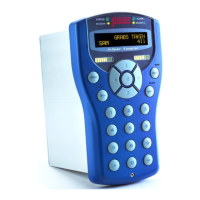Figure 8 - Select & Assign Screens
2.5 REGISTERS
A register is a piece of memory that can be thought of as a location containing a single data item of a
certain type. The registers are stored in memory that is non-volatile so that when the unit is turned off the
contents of the registers remains intact. Registers are used by the system for storing information that must be
remembered, e.g. calibration constants, accumulated volumes, etc. Each register has a unique number and a
descriptive name. The name begins with a character plus an underscore. This prefix character identifies what sort
of register it is (see the types listed below). Some registers are given a default value but can be changed to suit
the particular application. Registers are split into six groups for storing different types of data.
Figure 9 - Register Display Screen
Each register is displayed with its associated number and value. In the above example, register 0 is
shown with its title F_VERSION and value 22.9999 above. The ‘F_’ preceding the name indicates that this is a
floating-point register. The prefixes for each type are:
• F_ → Floating Point Register
• I_ → Integer (Int16) Register
• L_ → Long (Int32) Register
• P_ → Pointer Register
• C_ → Char (Int8) Register
• S_ → String Register (20 characters long)
N: B: If you have previously entered a search pattern, pressing the left or the right cursor button in the
above (figure 6) register screen will invoke the previous search pattern. Otherwise, pressing the left or right
cursor button will bring up the search options as described in the register mode options section below.
2.5.1 REGISTER MODE OPTIONS
Six operations can be performed within the register display. Pressing the Mode (START) button
will bring up a list with the following options.
Set current, description, display, search, view mod add, set mod address.

